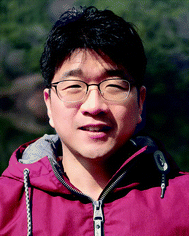Materials Horizons Emerging Investigator Series: Dae Sung Chung, Pohang University of Science and Technology (POSTECH), Korea
Prof. Dae Sung Chung received his BS in 2005 and PhD in 2010 at the Department of Chemical Engineering in Pohang University of Science and Technology (POSTECH), Korea. He was a postdoctoral researcher supervised by Prof. Dmitri V. Talapin at the University of Chicago for 2 years. He worked for Chung-Ang University and Daegu Gyeongbuk Institute of Science & Technology (DGIST) for 4 years and 3 years, respectively, as an assistant and associate professor. In 2020, he joined Pohang University of Science and Technology (POSTECH) as an associate professor. His research interests include organic image sensors, M3D printing of organic electronics and molecular switch devices.
Read Dae Sung Chung's Emerging Investigator Series article “A regioregular donor–acceptor copolymer allowing a high gain–bandwidth product to be obtained in photomultiplication-type organic photodiodes” and read more about him in the interview below:
MH: Your recent Materials Horizons Communication reports a new donor–acceptor copolymer as the active layer of a photomultiplication-type organic photodiode resulting in a high gain-bandwidth product. How has your research evolved from your first article to this most recent article and where do you see your research going in future?
DSC: Our work on photomultiplication-type organic photodiodes (PM-OPDs) started relatively recently (2018). In the early days, our interests were mainly on improving the chemical structure of the material and the physical structure of the device to further increase the external quantum efficiency (EQE), which is the main advantage of PM-OPDs. Through these efforts, EQE has been continuously improved, but the slow response speed, which is the biggest drawback of PM-OPDs, has not been improved at all, but rather worsened. Therefore, in this paper, we report on a new material/device combination that can realize fast response speed without sacrificing the high EQE of PM-OPDs.
MH: What aspect of your work are you most excited about at the moment?
DSC: As can be seen from the fact that the gain-bandwidth forms a constant value in a general photodetector, it can be predicted that the PM-OPD also has to sacrifice a fast response speed in order to achieve a high EQE. However, in this paper, we showed that minimizing the charge trap states of the photoactive layer can minimize the sacrifice of the response rate, and I think this is the most interesting point we have identified.
MH: In your opinion, what are the most important questions to be asked/answered in this field of research?
DSC: PM-OPDs' EQE is stagnant at around 100![[thin space (1/6-em)]](https://www.rsc.org/images/entities/char_2009.gif) 000%. So we think the following questions are important. “To what level can the EQE be improved according to material/device optimization of the PM-OPD?”, and accordingly, “What level will the response time be for the PM-OPD?”
000%. So we think the following questions are important. “To what level can the EQE be improved according to material/device optimization of the PM-OPD?”, and accordingly, “What level will the response time be for the PM-OPD?”
MH: What do you find most challenging about your research?
DSC: Because the main application fields of OPDs are expanding not only to cameras, but also to finger/vein/iris recognition sensors and bio-signal sensors, which are operated primarily by weak light sources, PM-OPDs can be a promising candidate for the commercialization of OPDs based on their self-signal amplification behavior. Therefore, implementing a high resolution image sensor with an active pixel structure of 500 ppi or higher using PM-OPDs will be our next challenge.
MH: In which upcoming conferences or events may our readers meet you?
DSC: If the COVID-19 situation eases, I will probably attend the MRS 2021 Fall meeting.
MH: How do you spend your spare time?
DSC: It seems that perusing theses or books in a slightly different field can help us come up with new ideas. It has the effect of allowing us to see our experimental results from a whole new perspective.
MH: Can you share one piece of career-related advice or wisdom with other early career scientists?
DSC: It's important to always discover new ideas, but I think it's also important to keep working on one research topic. Although the idea that came suddenly may be very cool, it cannot become the identity of a researcher like the results of research that has been conducted continuously for a long time.
| This journal is © The Royal Society of Chemistry 2021 |

